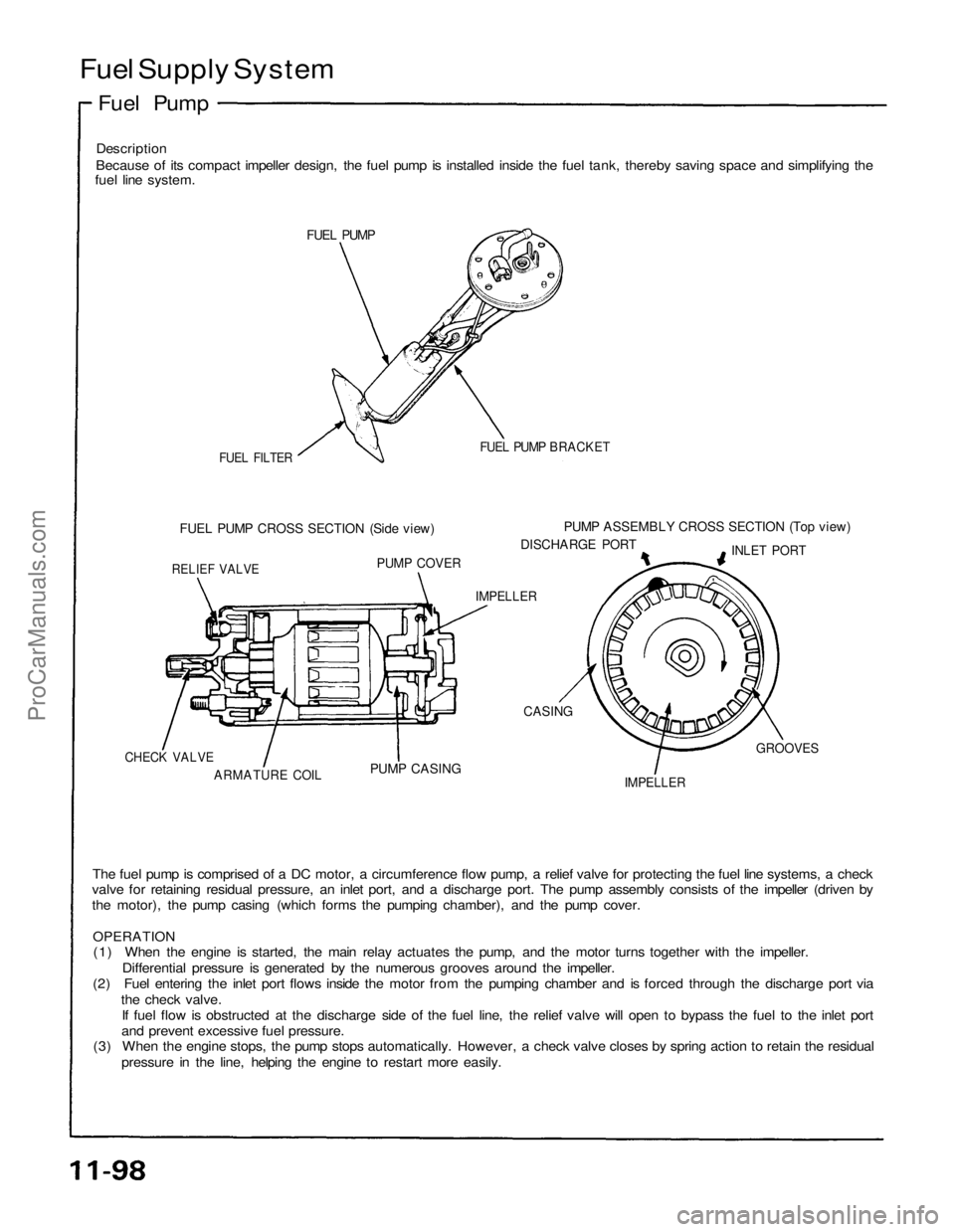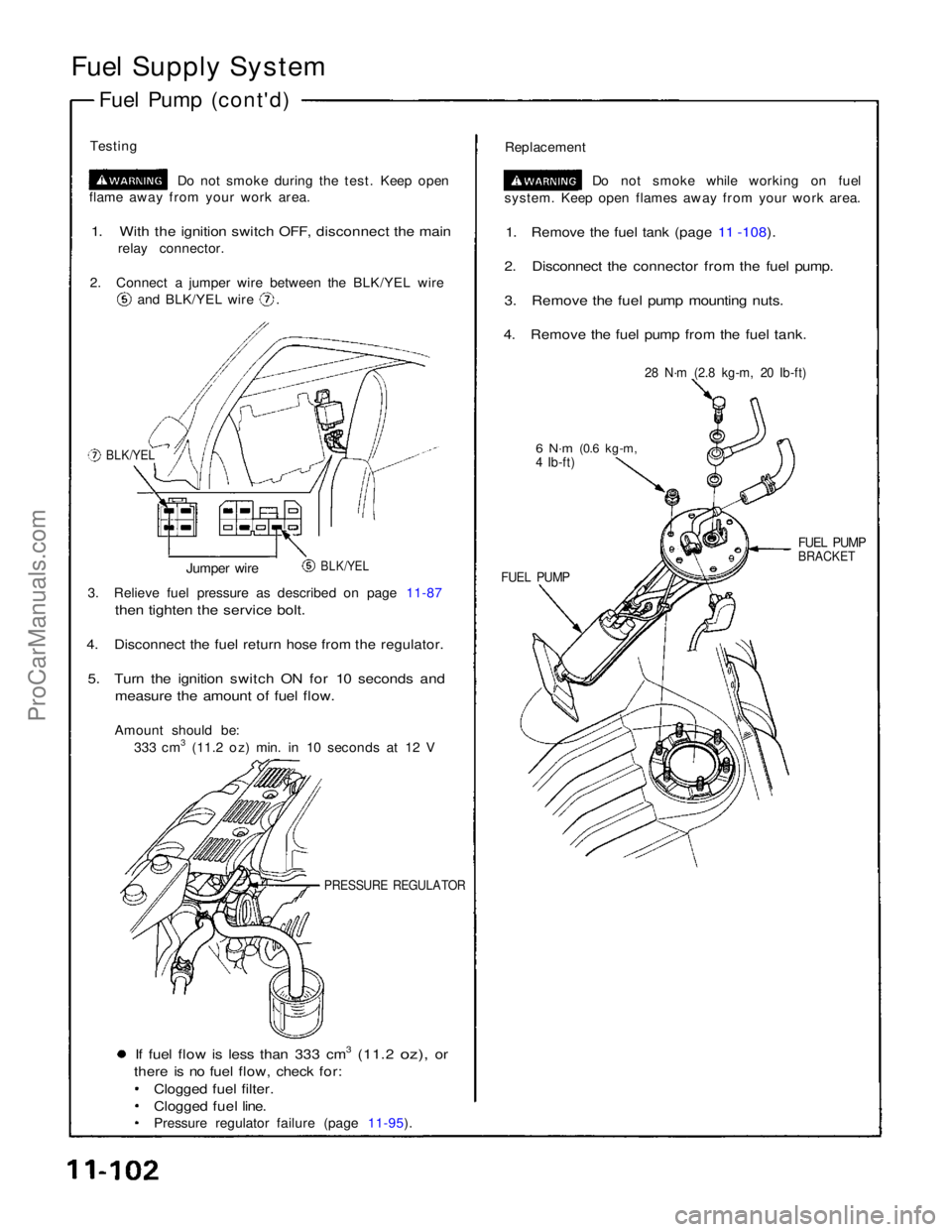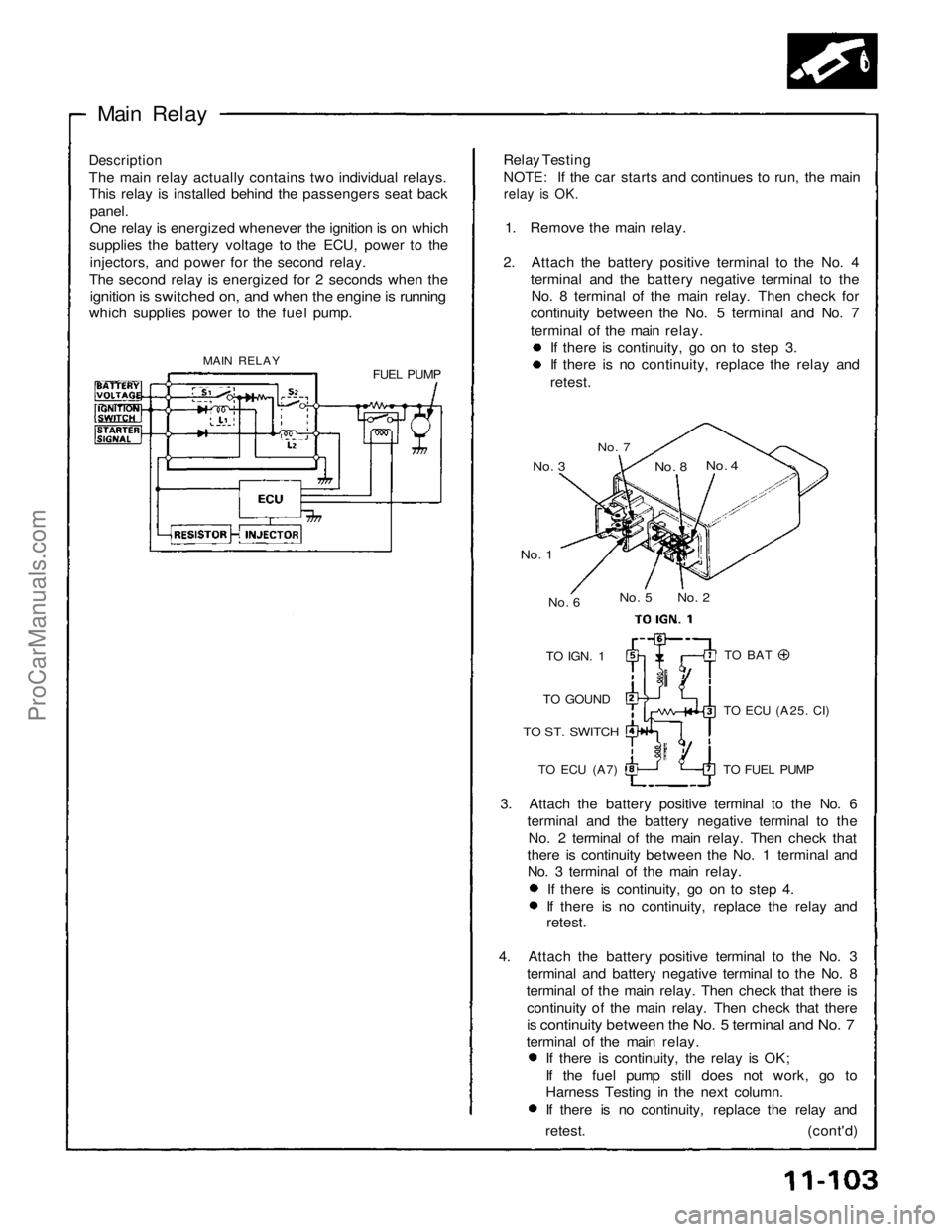Page 1504 of 1640
Fuel Supply System
Injector Resistor
Description
The resistor lowers the current supplied to the injectors
to prevent damage to the injector coils. This allows a
faster response time of the injectors.
Testing
1. Disconnect the resistor connector.
2. Check for resistance between each of the resistor
terminals (b, c, d, e, f and g) and the power terminal
(a).
Resistance should be: 5—7
INJECTOR
RESISTOR
MAIN
RELAY
ECU
INJECTOR RESISTOR
INJECTORS
Replace the resistor with a new one if any of the
resistances are outside of the specification.ProCarManuals.com
Page 1508 of 1640

Fuel Supply System
Fuel Pump
Description
Because of its compact impeller design, the fuel pump is installed inside the fuel tank, thereby saving space and simplifying the
fuel line system.
FUEL PUMP
FUEL FILTER
FUEL PUMP BRACKET
FUEL PUMP CROSS SECTION (Side view)
PUMP ASSEMBLY CROSS SECTION (Top view)
DISCHARGE PORT
INLET PORT
RELIEF VALVE
PUMP COVER
IMPELLER
CASING
IMPELLER
GROOVES
PUMP CASING
ARMATURE COIL
CHECK VALVE
The fuel pump is comprised of a DC motor, a circumference flow pump, a relief valve for protecting the fuel line systems, a check
valve for retaining residual pressure, an inlet port, and a discharge port. The pump assembly consists of the impeller (driven by
the motor), the pump casing (which forms the pumping chamber), and the pump cover.
OPERATION
(1) When the engine is started, the main relay actuates the pump, and the motor turns together with the impeller.
Differential pressure is generated by the numerous grooves around the impeller.
(2) Fuel entering the inlet port flows inside the motor from the pumping chamber and is forced through the discharge port via
the check valve.
If fuel flow is obstructed at the discharge side of the fuel line, the relief valve will open to bypass the fuel to the inlet port
and prevent excessive fuel pressure.
(3) When the engine stops, the pump stops automatically. However, a check valve closes by spring action to retain the residual
pressure in the line, helping the engine to restart more easily.ProCarManuals.com
Page 1509 of 1640

Fuel Supply System
Fuel Pump (cont'd)
Testing Do not smoke during the test. Keep open
flame away from your work area.
1. With the ignition switch OFF, disconnect the main
relay connector.
2. Connect a jumper wire between the BLK/YEL wire and BLK/YEL wire .
Replacement
Do not smoke while working on fuel
system. Keep open flames away from your work area.
1. Remove the fuel tank (page 11 -108).
2. Disconnect the connector from the fuel pump.
3. Remove the fuel pump mounting nuts.
4. Remove the fuel pump from the fuel tank.
BLK/YEL
28 N·m (2.8 kg-m, 20 Ib-ft)
6 N·m
(0.6 kg-m,
4 Ib-ft)
BLK/YEL
Jumper wire
FUEL PUMP
FUEL PUMP
BRACKET
3. Relieve fuel pressure as described on page 11-87
then tighten the service bolt.
4. Disconnect the fuel return hose from the regulator.
5. Turn the ignition switch ON for 10 seconds and
measure the amount of fuel flow.
Amount should be: 333 cm3 (11.2 oz) min. in 10 seconds at 12 V
PRESSURE REGULATOR
If fuel flow is less than 333 cm3 (11.2 oz), or
there is no fuel flow, check for:
Clogged fuel filter.
Clogged fuel line.
Pressure regulator failure (page 11-95).ProCarManuals.com
Page 1510 of 1640

Main Relay
Description
The main relay actually contains two individual relays. This relay is installed behind the passengers seat back
panel.
One relay is energized whenever the ignition is on which
supplies the battery voltage to the ECU, power to the
injectors, and power for the second relay.
The second relay is energized for 2 seconds when the
ignition is switched on, and when the engine is running
which supplies power to the fuel pump.
MAIN RELAY FUEL PUMPRelay Testing
NOTE: If the car starts and continues to run, the main
relay is OK.
1. Remove the main relay.
2. Attach the battery positive terminal to the No. 4 terminal and the battery negative terminal to theNo. 8 terminal of the main relay. Then check for
continuity between the No. 5 terminal and No. 7
terminal of the main relay. If there is continuity, go on to step 3. If there is no continuity, replace the relay and
retest.
No. 7
No. 3
No. 4
No. 8
No. 2
No. 5
No. 6
No. 1
TO
IGN.
1
TO GOUND
TO ST. SWITCH
TO ECU
(A7)
TO BAT
TO ECU
(A25.
CI)
TO FUEL PUMP
3. Attach the battery positive terminal to the No. 6 terminal and the battery negative terminal to theNo. 2 terminal of the main relay. Then check that
there is continuity between the No. 1 terminal and No. 3 terminal of the main relay.
If there is continuity, go on to step 4. If there is no continuity, replace the relay and
retest.
4. Attach the battery positive terminal to the No. 3 terminal and battery negative terminal to the No. 8
terminal of the main relay. Then check that there is
continuity of the main relay. Then check that there
is continuity between the No. 5 terminal and No. 7
terminal of the main relay. If there is continuity, the relay is OK;
If the fuel pump still does not work, go to
Harness Testing in the next column.
If there is no continuity, replace the relay and
retest. (cont'd)ProCarManuals.com
Page 1511 of 1640
Fuel Supply System
Main Relay (cont'd)
Troubleshooting Flowchart
Engine will not start.
Inspection of main relay.
Disconnect the main relay con-
nectors.
Measure the voltage between YEL/BLU terminal and body
ground.
Is there battery voltage? Replace ACG fuse.
Turn the ignition switch ON.
Measure the voltage between BLK/YEL terminal and body
ground.
Replace No. 2 fuse.
Is there battery voltage?
Measure the voltage between BLK/YEL terminal and body
ground.
Is there battery voltage? Replace IG COIL fuse. MAIN RELAY
BLK/
WHT
GRW
BLK
YEL/BLK
BLK/YEL
BLK/YEL
YEL/BLU
BLK
BLK/YEL
Turn the ignition switch START
position with the clutch pedal
depressed.
Measure the voltage between BLK/WHT terminal and body
ground.
Is there battery voltage? Replace No. 7 fuse.
(To page 11-105)ProCarManuals.com
Page 1512 of 1640
(From page 11-104)
Turn the ignition switch off.
Connect the ECU test harness
between the ECU and connector.
Disconnect "A" connector from
the ECU only, not the main wire
harness (page 11-21).
Check for continuity between GRN/BLK terminal and A7 ter-
minal.
Does continuity exist?
Repair open in GRN/BLK wire
between ECU (A7) and Main
Relay.
battety voltage?
A23
A25
Reconnect "A" connector to the
ECU. Reconnect the main relay.
Turn the ignition switch ON.
Measure the voltage between
A25 (+) terminal and A23 (-) ter-
minal.
Is there battery voltage?
Turn the ignition switch OFF.
Replace main relay.
1V or less
A7
A23
Measure the voltage between A7
(+) terminal and A23 (-) terminal
when the ignition switch is first
turned ON. Is there 1V or less?
(for 2 seconds)
Replace main relay. Substitute a known-good ECU
and recheck. If prescribed
voltage is now available, replace
the original ECU.ProCarManuals.com
Page 1513 of 1640
Fuel Supply System
Fuel Pump Resistor
Troubleshooting Flowchart
Engine will not start.
Inspection of fuel pump
resistor.
Disconnect the fuel pump resis-
tor connector.
Measure the voltage between
BLK/YEL (+) (on harness side)
and body ground (-) when the ig-
nition switch is first turned ON.
Is there battery voltage?
(for 2 seconds)
Inspect the main relay (page
11-104)
Turn the ignition switch OFF.
FUEL PUMP
RESISTOR
JUMPER WIRE
Replace fuel pump resistor.
Install a jumper wire between
two terminals on the wire harness side of fuel pump
resistor.
Turn the ignition switch to
START position.
Does the engine start?
Turn the ignition switch OFF.
Disconnect the fuel pump con-
nector.
(To page 11-107)ProCarManuals.com
Page 1517 of 1640
System Description
The system supplies air for all engine needs. It consists of the air cleaner, air intake pipe, throttle body, EACV, fast idle
mechanism, and intake manifold. A resonator in the air intake pipe provides additional silencing as air is drawn into the
system.
ECU
EACV
TO MAIN
RELAY
BLU/RED
CHECK
VALVE
DASHPOT
DIAPHRAGM
YEL/BLK
FAST
IDLE
VALVEProCarManuals.com